Rates of women voter registrations are surging—particularly where reproductive rights are threatened
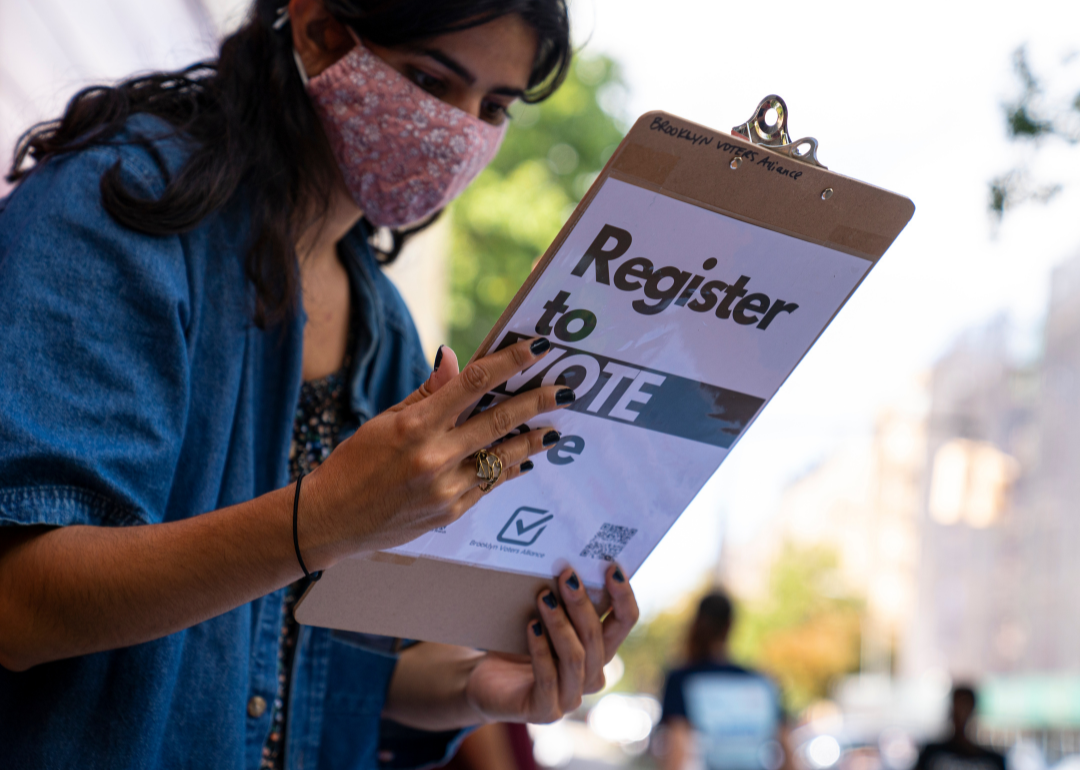
Robert Nickelsberg // Getty Images
Rates of women voter registrations are surging—particularly where reproductive rights are threatened
A volunteer from Brooklyn Voters Alliance checking a woman’s application after she registered to vote
The Supreme Court’s reversal of Roe v. Wade in June confirmed what many Americans already knew—that the highly polarizing issue of abortion would continue to divide people personally and politically. But the decision also had a less predictable outcome: Women have been registering to vote at very high rates in several conservative states where abortion access is either limited or practically nonexistent.
Across several states, the gender gap between men and women registering to vote ranged from 5% to 40% and was most pronounced in states where reproductive rights were most on the line. Meanwhile, states with more protections in place for abortion saw little to no uptick in women’s voter registrations.
While it’s too soon to say what impact this mobilization will have on midterm election results, some primary results may offer a glimpse of what’s to come. In Kansas, a proposed constitutional amendment to end the right to an abortion failed after voters decisively shot it down. And in New York, Democrat Pat Ryan won a congressional seat in a highly contested swing district after running a campaign centered on protecting abortion rights.
Stacker analyzed data from TargetSmart, a progressive data firm, to see how women’s voter registrations have changed since the Dobbs decision, which reversed decades of legal precedent protecting abortion. State rankings for legislation affecting abortion access are from the Guttmacher Institute.
Voters’ gender data is only collected using the labels ‘men’ and ‘women,’ meaning that it does not fully capture the extent to which people with nonbinary gender identities registered to vote. Similarly, abortion and reproductive rights impact more people than those who identify as women. For this article, “women” refers to people who marked that option on voter registration materials or whose state ID indicated that option.
You may also like: States that pay their politicians the most
![]()
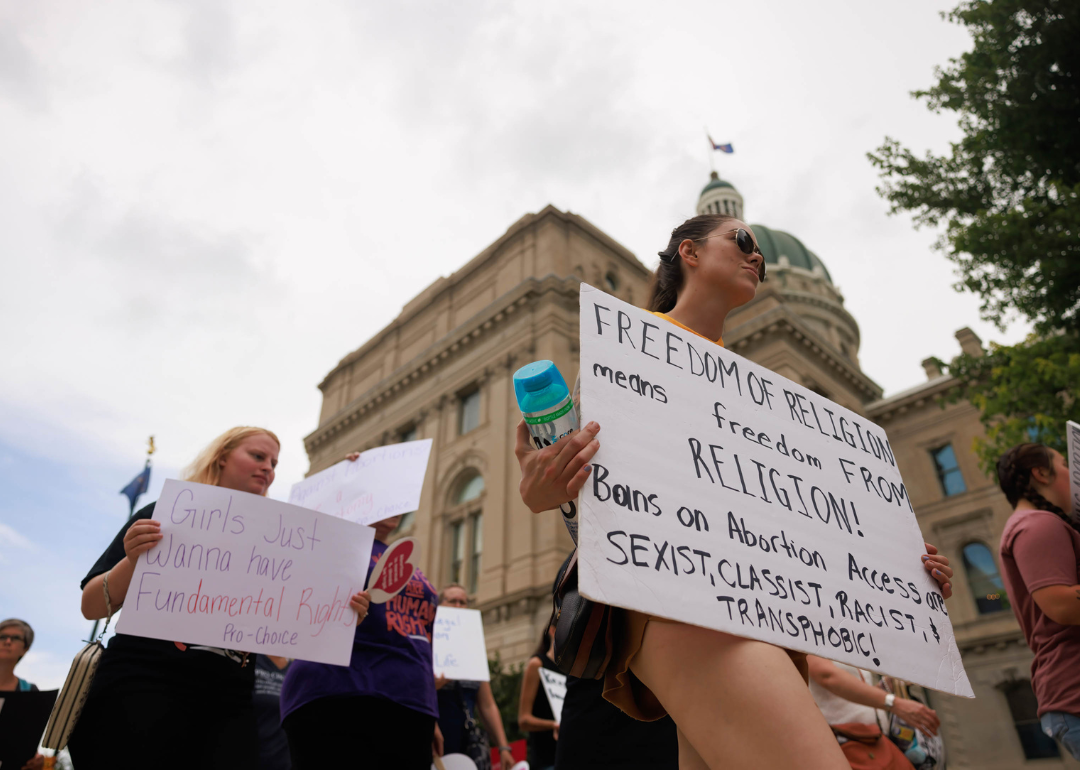
SOPA Images // Getty Images
Americans across the country broadly support access to abortion
Abortion-rights protesters marching around the Indiana State house during a demonstration
Public support for legal abortion is at one of the highest levels in over 25 years, according to a 2022 Pew Research poll. The majority of Americans, even when examined by race and ethnicity, gender, age, and education level, believe abortion should be legal in all or most cases. And while support for abortion still appears to be a partisan issue, the only groups with majority support for abortion bans are white evangelical Protestants and conservative-leaning Republicans.
Meanwhile, groups historically associated with the anti-abortion sentiment, like Catholics and more moderate Republicans, show majority support for legal abortion—a signal that views on the issue are changing.
Additional polling by the Kaiser Family Foundation in June 2022 indicates that two-thirds of Americans disapprove of the decision to overturn Roe v. Wade. And Republican senators’ mixed reception of South Carolina Sen. Lindsey Graham’s proposed federal 15-week abortion ban points to a lack of consensus within the party about whether and under what circumstances abortion should be illegal.
In 10 swing states where there is majority support for legal abortion—to different extents—Republicans are running on campaigns that vary widely from opposition to Graham’s bill to full-throated support for it.
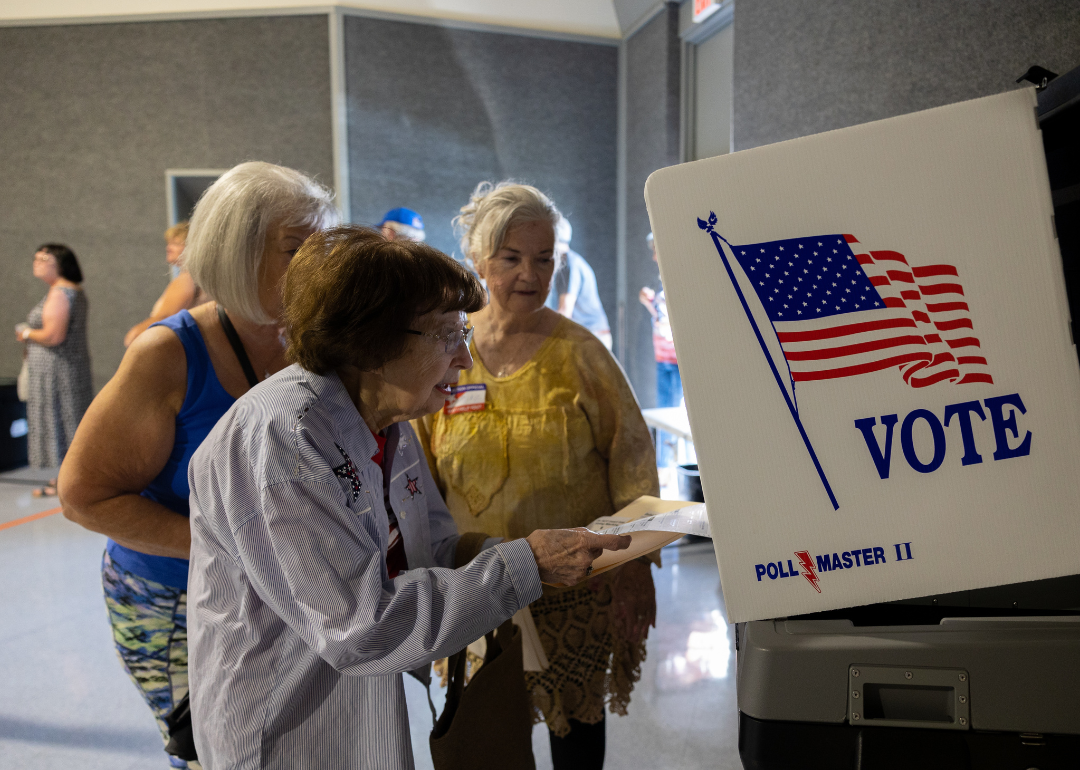
Anadolu Agency // Getty Images
Women have been registering to vote at increased rates in states where abortion access is most threatened
Voters casting their ballots at the Country Acres Baptist Church in Wichita, Kansas, on Tuesday, August 2nd, 2022, as voters decide on a constitutional amendment regarding abortion.
According to TargetSmart CEO Tom Bonier, the U.S. has seen significant increases in the rates of women registering to vote since the Dobbs decision came out in June. In particular, these increases have been in states that have either entirely banned abortion or have implemented restrictions to make it difficult to access.
The states seeing the most significant increases in women registering to vote since the overturning of Roe are Kansas, Arkansas, Pennsylvania, Arizona, and Ohio. This timing is no coincidence; there has also been an increase in women between 18 and 49 who report that abortion will be “very important” in their midterm voting decision-making.
Early results of the surge in voter registration are striking. In Kansas, where access to abortion is limited but still available, a vote resoundingly rejecting a proposed amendment to the state constitution that would have scrapped the right to abortion altogether prompted turnout numbers more comparable to a presidential election than a primary. This turnout was a stark repudiation of the movement to restrict abortion access further.
The defeat of the ballot measure, shot down by 59% of voters, came as a surprise to Kansas residents and those outside the largely conservative state. And it could be indicative of a potential nationwide shift in the decades-long partisanship surrounding the issue of abortion. While Kansas boasted the most dramatic increase in women registering to vote after the Dobbs decision, other states where access to abortion is on the line have also seen women substantially out-register men. On the other hand, states where abortion is already protected have not seen a specific uptick in women registering to vote.
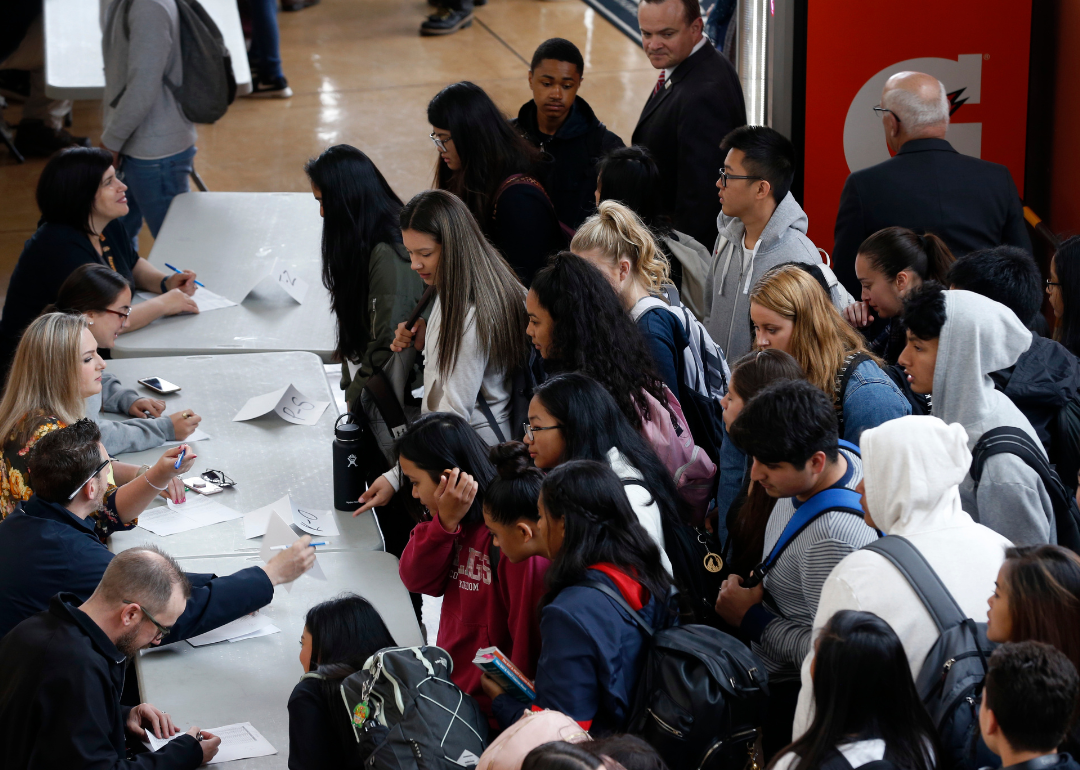
San Francisco Chronicle/Hearst Newspapers // Getty Images
Abortion and other issues have spurred enthusiasm from both parties ahead of midterms
Students waiting in line to check-in for voter registration
Midterm polling and primary results indicate that Democrats and Republicans are motivated to vote in the upcoming election by different things. Democrats have been galvanized by the overturning of Roe v. Wade, leading to new voter registrations since Roe was overturned and naming abortion as a top issue this midterms season. Meanwhile, most GOP voters have indicated that economic concerns, like inflation, are their primary motivators.
Democrat and Republican voters are neck and neck regarding their reported enthusiasm for casting a vote in the midterm elections—65% of Republicans say they are “extremely” or “very” enthusiastic, while 62% of Democrats said the same. And while enthusiasm and new voter registrations don’t always translate into more votes on election day, they can cause ripple effects: voters may bring friends to the polls, knock on doors for candidates, or participate in other political initiatives.
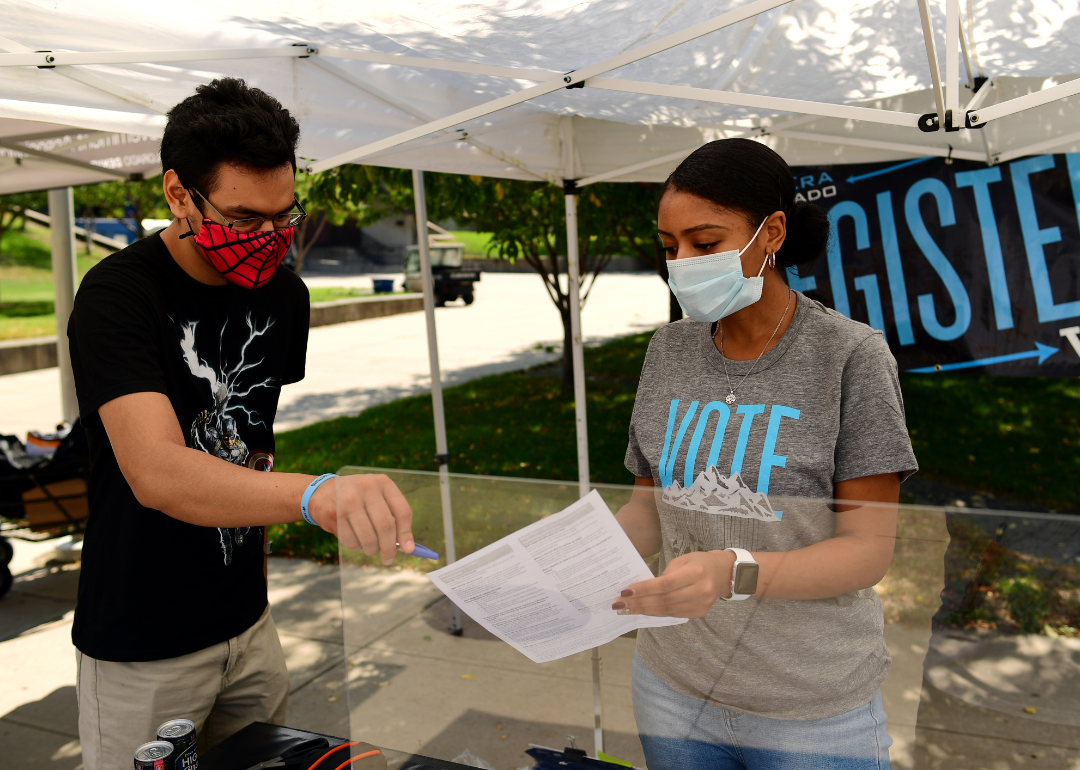
Hyoung Chang/MediaNews Group/The Denver Post // Getty Images
More young people are also registering in states where abortion is salient
Jazmyne Brooks of New Era Colorado, right, helping Saul Alfaro fill out a voter registration form at Auraria Campus in Denver, Colorado
In addition to the rise in women registering to vote, young people, a group known for low voter turnout, have also registered at unusually high rates in states where abortion access is threatened. In Michigan, Kansas, Nevada, Colorado, and North Carolina, young people have registered to vote at rates surpassing the youth voter registration surge in 2018. Among younger voters, young women are out-registering young men.
In Kansas, over half of the women who registered to vote after the Supreme Court overturned Roe were younger than 25. However, the youngest class of voters, 18- and 19-year-olds who recently became eligible, have lagged behind other young voters.
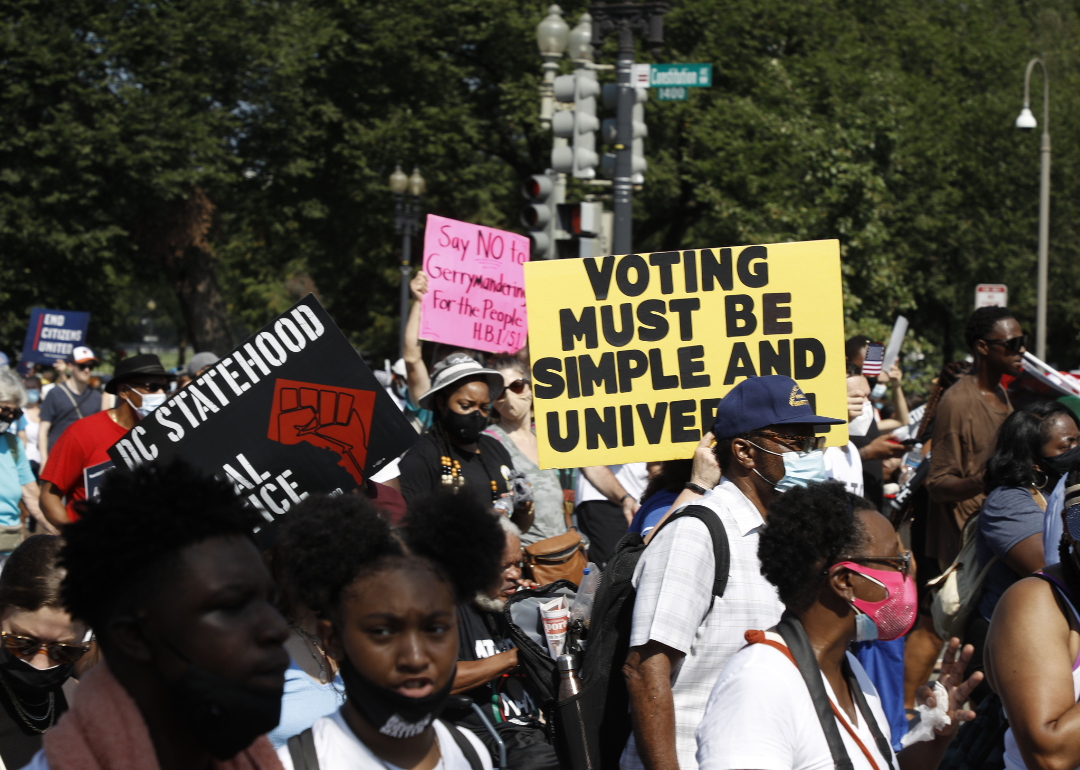
Anadolu Agency // Getty Images
What new registrations mean when it comes to election day and beyond
People marching for voters’ rights in Washington, D.C.
More significant numbers of women registering to vote may indicate increased support for Democratic candidates come election day, especially since women have historically turned out to vote at higher rates than men and are more likely to be Democrats. Still, Tom Bonier of TargetSmart is wary of making any concrete predictions.
“What we’re seeing is the entire political landscape changing. This is so, so different from trends in the past,” Bonier told Stacker. He acknowledged that registrations among young people also saw an uptick in 2018, particularly in response to the Parkland school shooting and the subsequent youth-led March For Our Lives movement. These registrations did eventually show up as higher turnout and increased early voting.
But voter registration rates amongst women and young people have outstripped even those of 2018’s midterm cycle. Abortion legislation, more than individual candidates, seems to have galvanized voters. “Elections where abortion is directly on the ballot, like Kansas, seem to be showing this impact,” Bonier said.
You may also like: Women politicians who broke barriers